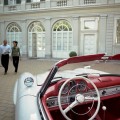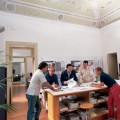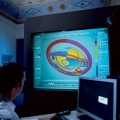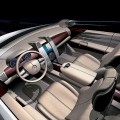-
 Daimler-Chrysler’s Top Secret Design Lab
Daimler-Chrysler’s Top Secret Design LabAt a Sprawling Italian Villa, a Team of Designers Is Combining Science with Style to Revolutionize Automotive Interiors
Architectural Digest
People are always a little shocked when I say we’re working on 2009,” says Verena Kloos, managing director of DaimlerChrysler Advanced Design Italia (ADI). “We’re already functioning in the future with the information we’ve gathered in the past.”
Kloos is speaking from her headquarters at the Villa Salazar, an 18th-century Neoclassical building in Como, Italy, formerly owned by Gianni Versace. Responsible for planning and designing passenger-car interiors for Mercedes-Benz, she’s one of the most powerful women in the automotive industry.
In the early 1990s, when Kloos was barely 30, Volkswagen sent her to California to head its first U.S. design studio. By the end of the decade she’d moved on to the team that developed the phenomenally successful microcar, the smart, in Europe. In 2000 DaimlerChrysler dispatched her to Italy, where she now leads a group of 17 designers from the worlds of fashion, interior design, engineering and automotive design. The influence Kloos has had on Mercedes’ mass-production cars will finally start to show in the 2005 model year.

In an 18th-century villa on the shores of Italy’s Lake Como, specialists at Daimler-Chrysler’s interior design lab, known as Advanced Design Italia (ADI), are ushering in the future of Mercedes-Benz interiors.
“Como is the end of the Silk Road and is famous for silk and wool production,” Kloos notes. “Milan, nearby, has at least a thousand design consultancy firms. They’re small, agile and creative—and very fast-moving. It’s wonderful.” These firms are ADI’s lifeblood, allowing it to take a futuristic approach to car interiors, incorporating glass, wood, metal and fabric applications that transition methodically from sketch to clay model to mock production car. The work that Kloos and her colleagues begin today must retain its appeal for 20 to 25 years. In other words, the 2009 interior that ADI is designing right now will finish its production run after a seven-year cycle in 2016—and is expected to remain fully roadworthy until 2025. “Automobiles are the most complex consumer products that exist,” she says.
The design process in Como begins as a mere construct in a sea of abstractions. Someone suggests a vehicle for two people on a holiday, for example, or something for the young urban couple—of the future, naturally—with kids. The brief takes into account lifestyle, income and spatial requirements. As the process moves forward, Kloos’s team shares its information with one of the Mercedes-Benz exterior group studios in Japan, Germany or the United States. “For a long period of time, data moves both ways, and it’s a dynamic process,” she says. “We get closer and closer, and then suddenly a parameter changes—a breakthrough in technology that allows us to use a space-saving device, for instance—and our work changes. Then, one day, it freezes into place.”
Traditionally, automotive design has begun with the exterior shape, which has then influenced the interior—especially with a car like a Mercedes-Benz, which is loaded with iconic elements. As people spend more time in their cars, however, they’re becoming hypersensitive to the architecture, to the point where interior design can now determine exterior design.
“Exterior design is about creating a sculpture, something you can walk around, using small-scale models that can be digitized or computer milled,” Kloos says. “With interior design, we always use a one-to-one scale; otherwise it has no meaning at all. You have to sit and have a sense of the room—to know where the Apillar’s going, or how high the dashboard will be. If your perception of the roofline is that it’s too low, it completely changes your feelings.”
Miniaturization, increasingly a fact of life in automotive interior design, has become a bête noire for Kloos and her team. ADI’s challenge is to offer all the latest technical accoutrements while keeping the interior simple and user-friendly. Electronic systems that allow a car to automatically maintain a distance from the one preceding it, for example, or that enable a driver to back into a parking space without looking out the rear window, diminish the importance of sightlines and provide even more distractions from the driving experience, Kloss believes. “Personally, I find these systems make me so passive that I’ve chosen not to have them for my new car,” she says firmly. “To have control, I must be aware of the overall length of my car. I don’t want that much convenience.”
Ultimately, Kloos must state her case to the engineers in Germany who will realize her designs, as well as to the exterior designers who may or may not share her agenda. “We fight for aesthetics, for high emotional appeal and for an innovative approach, which is usually the position of the designer,” she says. She feeds examples to the “strict and serious” engineers to warm them up. “Our design position is to conceptualize an excellent product, respecting function, for sure, but not before aesthetics.”
Kloos’s aesthetic has been changing. For inspiration, she looks to contemporary art, such as the work of Anselm Kiefer, instead of fashion—“pieces that are unique, tactile and rough”—and feels the modern furnishings at the annual Salone del Mobile in Milan have become tired. “I’m leaning toward real things again, not so cushioned, not so pampering,” she says. “Why shouldn’t a seat be firm, so you recognize its contour?”
As a German woman running a business in Italy, Kloos has had to adjust to many things, especially time management. “I adapted,” she says. “I’m still adapting. I lived for many years in the United States, and I adapted to the concept of convenience and what-you-see-is-what-you-get. And I loved my time in California. But here in Italy I’ve learned the values of the so-called Old World, the authenticity. And I really started to appreciate it again.” MG
published January 2004
http://www.architecturaldigest.com/homes/homes/archive/daimler_article_012004









